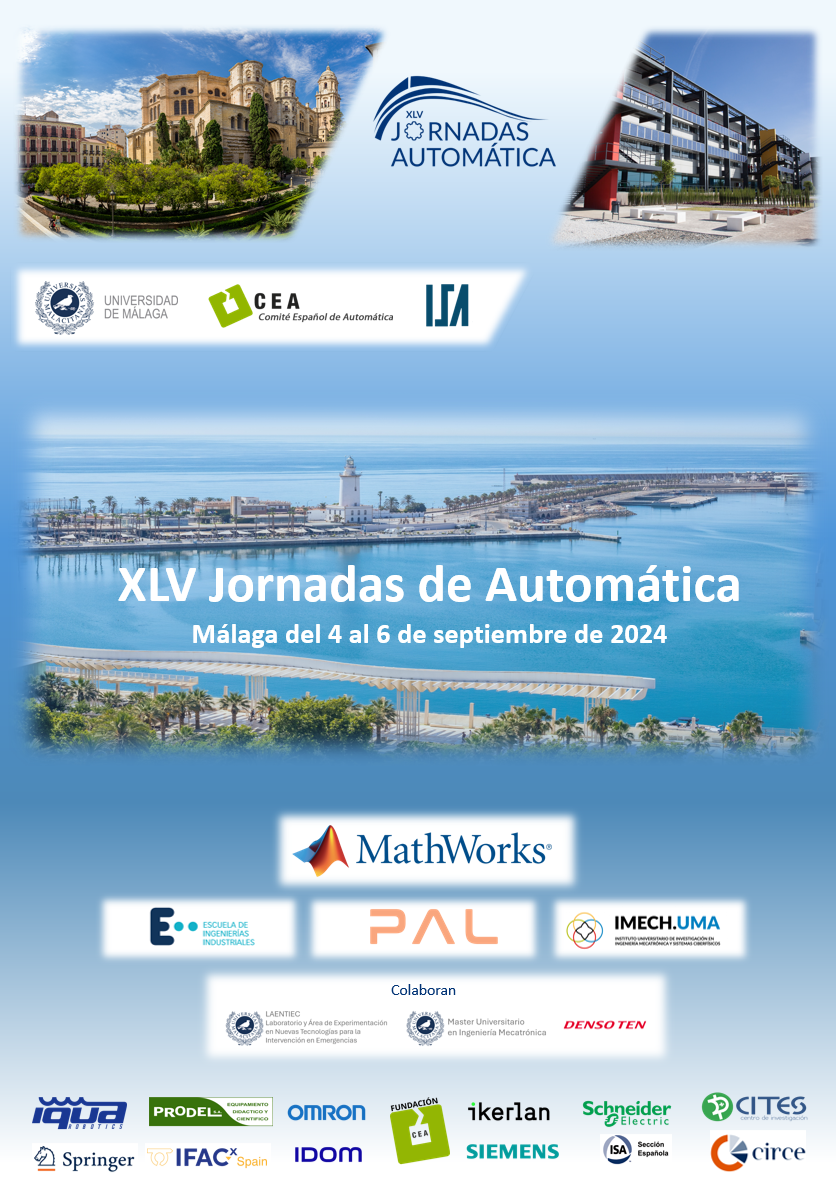Localización de emisiones de metano combinando un sensor TDLAS y un robot móvil
DOI:
https://doi.org/10.17979/ja-cea.2024.45.10893Palabras clave:
Robótica móvil, Robótica de campo, Percepción y detección, Percepción cooperativa, Teleoperación, Modelado e identificación de sistemas medioambientalesResumen
Este trabajo aborda el problema de la localización eficiente de emisiones de metano en espacios abiertos mediante el uso de robótica móvil. En contraposición a los métodos convencionales que emplean detectores puntuales, o que empleando medidores de rango dependen del suelo como reflector natural (los cuales conllevan largos tiempos e ineficientes trayectorias de inspección), se propone un enfoque robótico que aumenta la eficiencia de la toma de datos. Para ello se monta un detector de rango sobre una unidad pan-tilt que apunta continuamente a un robot móvil que actúa como reflector artificial, permitiendo tomar medidas sobre el plano horizontal. Este enfoque permite abarcar grandes superficies en cortos espacios de tiempo sin perder resolución espacial. Los resultados obtenidos en un área experimental de 140 m2 validan la efectividad de este enfoque para la rápida detección y localización de fuentes de emisión de gas metano.
Referencias
Aldhafeeri, T., Tran, M.K., Vrolyk, R., Pope, M., Fowler, M., 2020. A review of methane gas detection sensors: Recent developments and future perspectives. Inventions 5, 28.
Arain, M.A., Hernandez Bennetts, V., Schaffernicht, E., Lilienthal, A.J., 2021. Sniffing out fugitive methane emissions: autonomous remote gas inspection with a mobile robot. The International Journal of Robotics Research 40, 782–814. doi:10.1177/0278364920954907.
Bennetts, V.H., Schaffernicht, E., Stoyanov, T., Lilienthal, A.J., Trincavelli, M., 2014. Robot assisted gas tomography — localizing methane leaks in outdoor environments, in: IEEE International Conference on Robotics and Automation (ICRA), pp. 6362–6367. doi:10.1109/ICRA.2014. 6907798.
Bridgham, S.D., Cadillo-Quiroz, H., Keller, J.K., Zhuang, Q., 2013. Methane emissions from wetlands: biogeochemical, microbial, and modeling perspectives from local to global scales. Global change biology 19, 1325–1346. doi:10.1111/gcb.12131.
Byer, R.L., Shepp, L.A., 1979. Two-dimensional remote air-pollution monitoring via tomography. Optics Letters 4, 75–77. doi:10.1364/OL.4. 000075.
Corbett, A., Smith, B., 2022. A study of a miniature tdlas system onboard two unmanned aircraft to independently quantify methane emissions from oil and gas production assets and other industrial emitters. Atmosphere 13. doi:10.3390/atmos13050804.
Gålfalk, M., Nilsson Påledal, S., Bastviken, D., 2021. Sensitive drone mapping of methane emissions without the need for supplementary ground- based measurements. ACS Earth and Space Chemistry 5, 2668–2676. doi:10.1021/acsearthspacechem.1c00106.
Gongora, A., Monroy, J., Gonzalez-Jimenez, J., 2020. Joint estimation of gas & wind maps for fast-response applications. Applied Mathematical Modelling doi:10.1016/j.apm.2020.06.026.
Kupers, R., et al., 2023. United Nations Environment Program. An Eye on Methane. Technical Report. International Methane Emissions Ob- servatory (IMEO). doi:https://wedocs.unep.org/handle/20.500. 11822/44129.
Kwásny, M., Bombalska, A., 2023. Optical methods of methane detection. Sensors 23. doi:10.3390/s23052834.
Li, F., Cai, H., Xu, J., Zhang, K., Feng, Q., Wang, H., 2020. Gas distribution mapping for indoor environments based on laser absorption spectroscopy: Development of an improved tomographic algorithm. Building and Environment 172, 106724. doi:10.1016/j.buildenv.2020.106724.
Monroy, J., Blanco, J.L., Gonzalez-Jimenez, J., 2016. Time-variant gas distribution mapping with obstacle information. Autonomous Robots 40, 1–16. doi:10.1007/s10514-015-9437-0.
Monroy, J., Ojeda, P., Gonzalez-Jimenez, J., 2024. A Feasibility Study of a Leader-Follower Multi-robot Formation for TDLAS Assisted Methane Detection in Open Spaces, in: Marques, L., Santos, C., Lima, J.L., Tardioli,D., Ferre, M. (Eds.), Robot: Sixth Iberian Robotics Conference, Springer Nature Switzerland. pp. 181–192. doi:10.1007/978-3-031-58676-7_15.
Mønster, J., Kjeldsen, P., Scheutz, C., 2019. Methodologies for measuring fugitive methane emissions from landfills – a review. Waste Management 87, 835–859. doi:10.1016/j.wasman.2018.12.047.
Neumann, P.P., Kohlhoff, H., H¨ullmann, D., Lilienthal, A.J., Kluge, M., 2017. Bringing mobile robot olfaction to the next dimension — uav-based remote sensing of gas clouds and source localization, in: IEEE International Conference on Robotics and Automation (ICRA), pp. 3910–3916. doi:10.1109/ICRA.2017.7989450.
Saunois, M., Stavert, A.R., Poulter, B., Bousquet, P., Canadell, J.G., Jackson, R.B., Raymond, P.A., Dlugokencky, E.J., Houweling, S., Patra, P.K., et al., 2019. The global methane budget 2000–2017. Earth System Science Data Discussions 2019, 1–136.
Themelis, N.J., Ulloa, P.A., 2007. Methane generation in landfills. Renewable energy 32, 1243–1257. doi:10.1016/j.renene.2006.04.020
Descargas
Publicado
Número
Sección
Licencia
Derechos de autor 2024 Pepe Ojeda, Javier Monroy, Javier González-Jiménez

Esta obra está bajo una licencia internacional Creative Commons Atribución-NoComercial-CompartirIgual 4.0.





